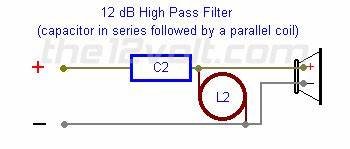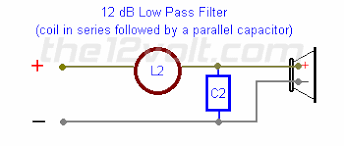So, just to be clear, your going to have a 20 W amp working into a passive crossover in each speaker enclosure?
Sorry i was not clear, i want to go passiveLooks like he wants to use active and passive at the same time?
I will have two 20w amp. So 20w for each enclosureSo, just to be clear, your going to have a 20 W amp working into a passive crossover in each speaker enclosure?
There is problem because the drivers are from old passive enclosure and i have no idea even the name of the drivers but they are good. I know that woofer is 4inch 12-25w 8ohm and tweeter is 1 inch 12-25w 8ohmPlease provide required driver details.
Very confusing. You posted active crossover you like in post #16. Why? If you want to go passive.
sorry I wrote it so confused. first i wanted to do a bi-amp but i already decided to make one amplifier which will power the woofer and tweeter so i need a passive crossoverVery confusing. You posted active crossover you like in post #16. Why? If you want to go passive.
I know that woofer is 4inch 12-25w 8ohm and tweeter is 1 inch 12-25w 8ohm
In that case, I can only suggest a simple crossover circuit. It will divide the frequencies, but won't be the perfect match for the unknown drivers.
Would that be good for you?
One other question, how did you arrive at your requirement for a 2.8 kHz crossover frequency?
Oh! What about photos of the drivers?
Okay, I still wasn't sure because I didn't know what was best, but now I'm 100% sure. 20+20w is more than enought for my small room.Its ok. Everyone has the right to change their mind.
I can take a photo but not today because im not home but i will post it as soon as possible. 2.8 khz was the highest frequency at which the woofer was still somehow loud. When I went higher it was much quieterIn that case, I can only suggest a simple crossover circuit. It will divide the frequencies, but won't be the perfect match for the unknown drivers.
Would that be good for you?
One other question, how did you arrive at your requirement for a 2.8 kHz crossover frequency?
Oh! What about photos of the drivers?
And also tweeter at that frequency was loud. Lower frequencies was quieter
Last edited:
2.8 khz was the highest frequency at which the woofer was still somehow loud. When I went higher it was much quieter
It sounds like you could run the the woofer direct from the amplifier and simply put a high pass filter in front of the tweeter.
We just have make sure the tweeter is adequately protected from the low frequencies.
The circuit for the tweeter high pass filter is shown in the first attachment.
The capacitor (C) can be a bipolar (non-polar or NP) type of value 4.7 uF.
The inductor (L) can be an air-core type of value 0.60 mH.
If the tweeter turns out to be too loud, then put a 5W or 10W ceramic wire-wound resistor of value 1.0 to 2.2 ohms in front of the capacitor.
(If necessary, you can put a low pass filter in front of the woofer. Use the same L and C values, but arrange them as shown in the second attachment.)
Attachments
A pair of 4" would be unlikely to produce more than 100dB SPL at 100Hz, (a frequency where you might cross them to a sub) at one meter.And also tweeter at that frequency was loud. Lower frequencies was quieter
By comparison, clapping your hands can produce 125dB peak in the 2-5kHz range.
Thank you very much, and also I completely forgot that when i look into the enclosure, there was 4.7uf capacitor in series with tweeter if that somehow helpsIt sounds like you could run the the woofer direct from the amplifier and simply put a high pass filter in front of the tweeter.
We just have make sure the tweeter is adequately protected from the low frequencies.
The circuit for the tweeter high pass filter is shown in the first attachment.
The capacitor (C) can be a bipolar (non-polar or NP) type of value 4.7 uF.
The inductor (L) can be an air-core type of value 0.60 mH.
If the tweeter turns out to be too loud, then put a 5W or 10W ceramic wire-wound resistor of value 1.0 to 2.2 ohms in front of the capacitor.
(If necessary, you can put a low pass filter in front of the woofer. Use the same L and C values, but arrange them as shown in the second attachment.)
Yes, the very simplest form of crossover is a capacitor in series with the tweeter.
If you want to keep it very simple, then run the woofer direct from the amp and put a capacitor of value 2.2 to 4.7 uF in series with the tweeter.
The tweeter is less likely to get overloaded by low frequencies if you use the lower capacitor value.
It's worth experimenting with the capacitor value!
EDIT: Changed higher to lower capacitor value - a slip of the brain!
If you want to keep it very simple, then run the woofer direct from the amp and put a capacitor of value 2.2 to 4.7 uF in series with the tweeter.
The tweeter is less likely to get overloaded by low frequencies if you use the lower capacitor value.
It's worth experimenting with the capacitor value!
EDIT: Changed higher to lower capacitor value - a slip of the brain!
Last edited:
Thanks, that is very helpful. I was powering these speakers with some cheap 50+50w amp from Aliexpress and no problem but because it was some cheap amplifier it was quickly destroyed. So i decided to use 20+20w using lm1875 that i thing is much better chipYes, the very simplest form of crossover is a capacitor in series with the tweeter.
If you want to keep it very simple, then run the woofer direct from the amp and put a capacitor of value 2.2 to 4.7 uF in series with the tweeter.
The tweeter is less likely to get overloaded by low frequencies if you use the lower capacitor value.
It's worth experimenting with the capacitor value!
EDIT: Changed higher to lower capacitor value - a slip of the brain!
- Home
- Live Sound
- Instruments and Amps
- Two 20w studio monitors

